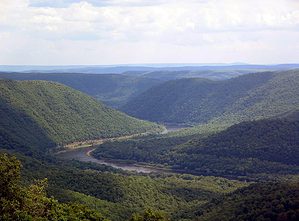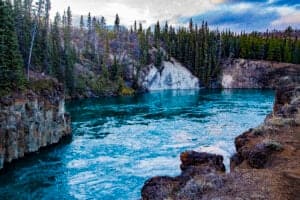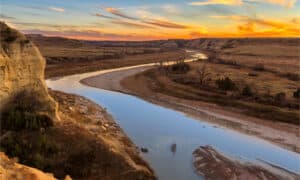Most people associate the term “Amazon” with the largest and most prominent online retail center, which connects buyers and producers across the globe. However, the name “Amazon” is derived from one of the longest rivers in the world, the Amazon River, which stretches for 4,345 miles. The Amazon River is located on the South American continent, starting 100 miles inland from the Pacific Ocean and leading to the Atlantic Ocean. The Amazon River is surprisingly longer than the width of the Atlantic Ocean, so swimming the entirety of the river would be quite a feat!
10 Amazon River Fast Facts
- Experts continue to debate where the name “Amazon” originated. Some believe it was named by Francisco de Orellana, a Spanish explorer. Others claim that the name derives from the word “Amassona,” which is a Native American term that means “boat destroyer.”
- Estimates report that the Amazon River pours out 10 times the amount of water into the Atlantic Ocean than that of the mouth of the Mississippi River.
- Depth of the Amazon River can range between 66 and 330 feet, depending on the season.
- The current of the Amazon River can travel up to four miles per hour.
- The Amazon River mainly flows through the South American countries of Peru and Brazil.
- There are 1,100 tributaries in the Amazon River, which reach into other countries within South America, including but not limited to Ecuador, Venezuela, and Colombia.
- Before the Andes Mountains came into being, the Amazon River likely flowed in the opposite direction in which it flows today, toward the Pacific Ocean rather than toward the Atlantic Ocean.
- The Amazon River is full of and surrounded by a limitless amount of biodiversity, including animals like the piranha and the capybara.
- Deforestation in the Amazon Rainforest, which surrounds a large portion of the Amazon River, threatens fish and other aquatic animals. Tree roots hold in soil, but when these trees are cut down, soil becomes loose and results in runoff. Runoff can cause numerous environmental issues, such as eutrophication, which kill aquatic life.
- On the Amazon River, overfishing is a problem that both decreases biodiversity and disrupts aquatic habitats.
Dangers of the Amazon River
Although swimming the length of the Amazon River might sound like an amazing adventure, many dangers accompany the journey. Diseases and infections like malaria threaten those who travel deep into the Amazon. Furthermore, the Amazon region is one of the most biodiverse areas in the world, and with biodiversity comes a plethora of terrifying animal encounters. Below describe some of the worst dangers of Amazonian wildlife.
Snakes
Snakes like the green anaconda and the pit viper are not only frightening but can be fatal. The green anaconda can measure over 30 feet in length and is considered the largest snake on Earth! This snake species wraps around its prey and suffocates them to death. After, the green anaconda swallows its prey in one piece! On the other hand, the pit viper is intimidating and venomous. Their venom is formidable and likely fatal.
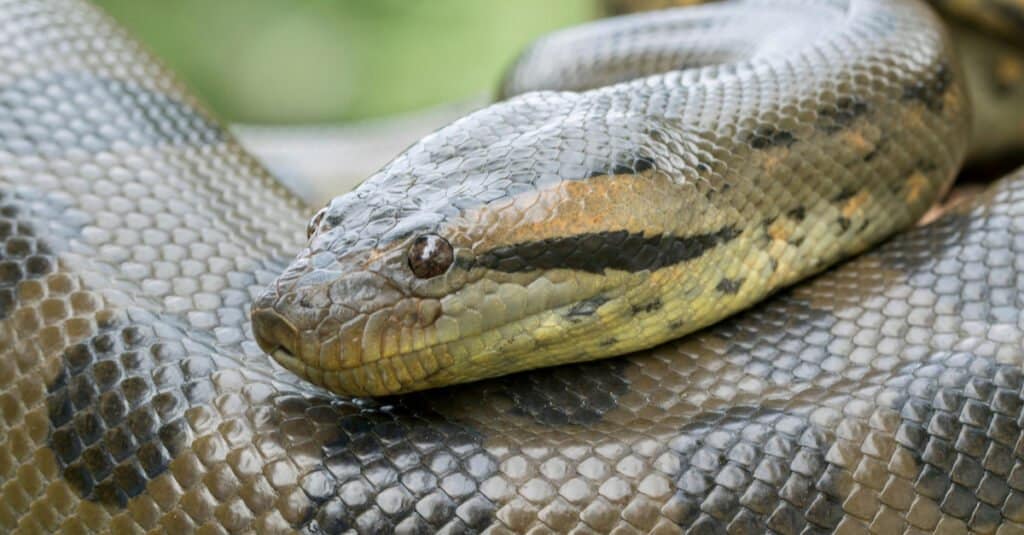
The anaconda is the largest snake on the planet and one of the dangers of the Amazon River.
©Mark_Kostich/Shutterstock.com
Fish
The piranha is probably the most well-known fish that swims in the Amazon River. Piranhas attack their victims by ripping apart their skin and muscle in a frenzy. Piranhas have extremely sharp teeth and red-colored eyes that make them appear as menacing. However, piranhas aren’t as aggressive as they may seem or have been portrayed in media. In fact, Piranhas aren’t unsafe to swim with in most areas of the Amazon River.
Another formidable fish is the bull shark, which is the most dangerous shark in the world. They can weigh up to 700 pounds and reach 11 feet in length. These animals are extremely aggressive and have been known to rip apart large aquatic species. Luckily, bull shark spottings in the Amazon are rare, but if you’re looking to swim the entire length of the Amazon, keep your guard up!
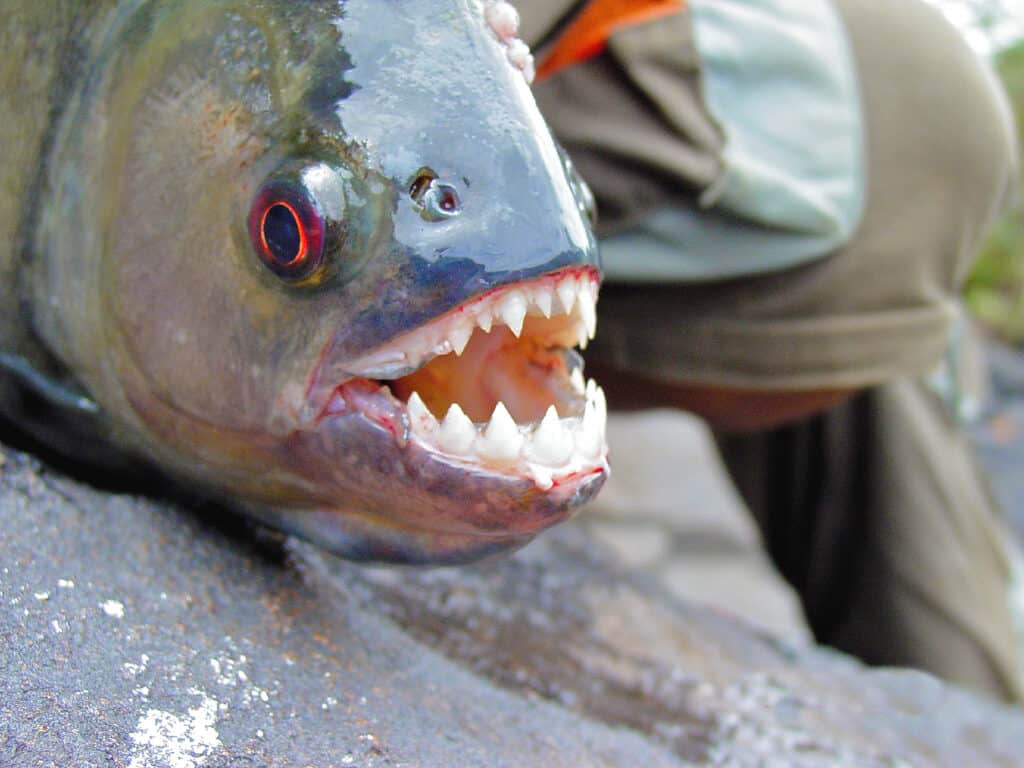
Despite how dangerous piranha look they are not as aggressive as their teeth may make you believe.
©The Jungle Explorer/Shutterstock.com
Amphibians
Poison dart frogs may look alluring with their bright colors and captivating patterns, but visitors of the Amazon should keep their distance. The species’ poison is so intense that it can be fatal in a matter of minutes. Poison dart frogs are one of the most toxic species in the world, so if you see one, stay back!
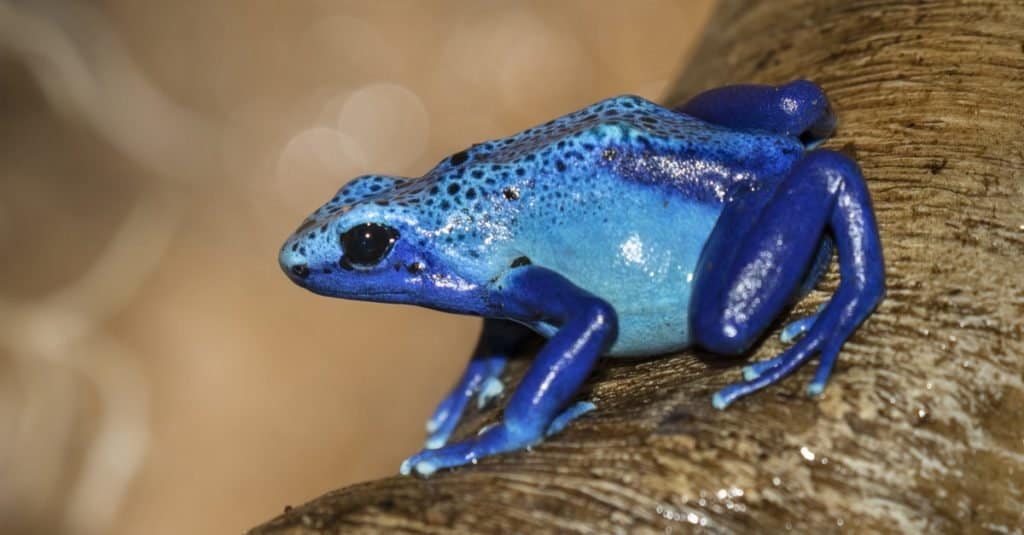
Poison dart frogs are among the most poisonous amphibians in the world.
©Natalia Kuzmina/Shutterstock.com
How Long it Would Take to Swim the Amazon River
The average person swims at a rate of one to two miles per hour. Therefore, it would take 120 days for someone to swim the entire 4,345 miles if they took no breaks. If someone were to swim for 12 hours every day, it would take twice as long, meaning the swimmer would conquer the Amazon River in about eight months. However, these estimates can fluctuate depending on the current strength of the river and whether a person is swimming upstream or downstream.
In addition, the rate of miles per hour that a person can swim is subject to factors like fitness, ability, weight, sex, and lung capacity. Therefore, it is difficult to provide a universal estimate of how long it might take to swim the Amazon River. Olympic swimmers, like Michael Phelps, can swim between four and six miles per hour. At this rate, Michael Phelps could swim the entire length of the amazon between 30.2 and 45.3 days without breaks and without changing his speed. However, these record-breaking swimming rates have only been achieved at short distances. The reality is that even Michael Phelps would not be able to maintain enough stamina and speed to swim the entire Amazon River in less than two months.
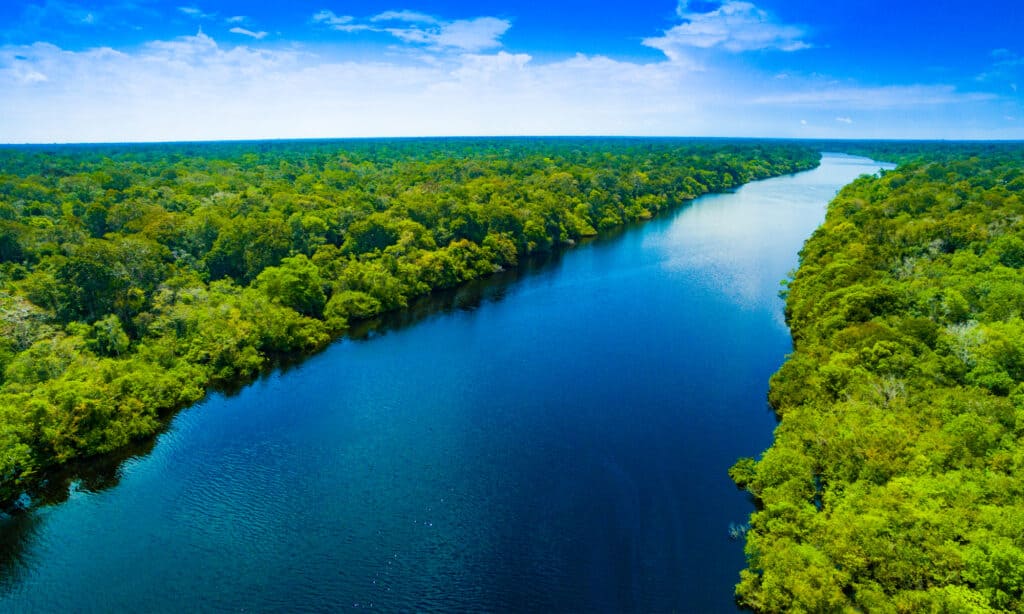
The Amazon River is located on the South American continent and stretches for 4,345 miles.
©worldclassphoto/Shutterstock.com
The Man who Swam the Amazon River
On April 8, 2007, a brave swimmer named Martin Strel conquered 3,274 miles of the Amazon River. Even more shocking, he swam for only 66 days! Strel is an experienced marathon swimmer who holds records for swimming various natural bodies of water like the Mississippi River and the Danube. He also swam from Africa to Europe in less than 30 hours without stopping!
Strel didn’t accomplish swimming the Amazon River without help, though. A crew followed him throughout the entire journey, but even his supporters couldn’t mitigate the effects that the swim left on Strel. When he finished the journey, his body was left in poor condition. He could barely walk, and his blood pressure skyrocketed.
Although Strel prepared both mentally and physically for the journey through rigorous exercise and psychological practices, many difficulties faced him during the expedition. For instance, poisonous animals and fish, like the piranha, threatened to attack him. Infections and diseases like malaria are prevalent throughout the Amazonian region, so avoiding catching a debilitating disease was a task of its own. Furthermore, pirates threaten the safety of the Amazon River, so Strel had to consult locals and do research to ensure that he wouldn’t run into trouble.
During his swim, Strel would go into a kind of hypnotic state, which would help distract him from physical and mental barriers. These moments allowed him to get in the zone and focus on what he needed to accomplish. In several instances, Strel would replay movies in his head or have mental conversations with God or his wife. In this way, time would melt away for Strel, empowering him to push further and focus on his goal without interruptions.
Many times, Strel felt like giving up. He was separated from his crew at times and encountered a plethora of issues along the route. However, he kept his strong mentality, overcoming the obstacles and achieving his dream in the end.
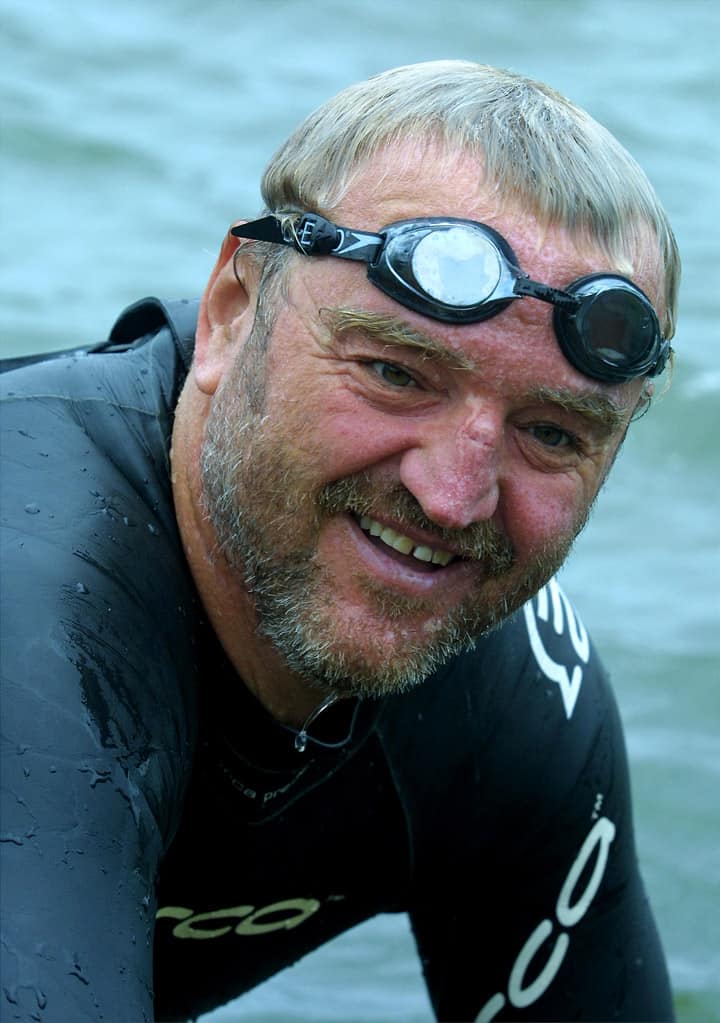
Martin Strel swam for 3,274 miles and 66 days on the Amazon River.
©Borutstrel, CC BY-SA 3.0 <https://creativecommons.org/licenses/by-sa/3.0>, via Wikimedia Commons – License
Up Next
- How Wide is the Amazon River at its Widest Point?
- All About the Amazon
- The 10 Longest Rivers in South America
The photo featured at the top of this post is © iStock.com/Rhett Ayers Butler - Mongabay
Sources
- David Barnard Ericson, Available here: https://www.britannica.com/place/Atlantic-Ocean
- Kidadl, Available here: https://kidadl.com/facts/how-fast-can-a-human-swim-who-holds-the-world-record-in-swimming
- Tim Ferriss, Available here: https://tim.blog/2008/07/01/swimming-the-amazon-3274-miles-on-the-worlds-deadliest-river/
- Bruna, Available here: https://www.iheartbrazil.com/amazon-river-facts/
- Britannica, Available here: https://www.britannica.com/place/Amazon-River/Physical-features
- Rainforest Cruises, Available here: https://www.rainforestcruises.com/guides/dangers-of-the-amazon-river
FAQs (Frequently Asked Questions)
Is it safe to swim in the Amazon River?
Swimming in the Amazon River is possible. However, many dangers exist within the river and the surrounding Amazon Rainforest. If a person chooses to swim in it, they should plan to be careful and to be aware of their surroundings.
What country is the Amazon River in?
The Amazon River mainly flows through Peru and Brazil, but certain portions and tributaries exist in surrounding countries, too.
How long is the Amazon River?
The Amazon River is approximately 4,345 miles long.
Thank you for reading! Have some feedback for us? Contact the AZ Animals editorial team.



